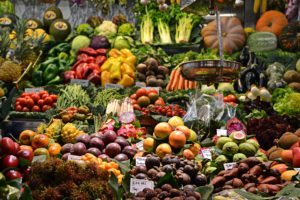Why is this important?
Procurement can make a real difference when it comes to cutting carbon emissions. Greenhouse gas (GHG) emissions in an organisation’s supply chain are, on average, 11.4 times higher than its operational emissions.(1) Driving emission reductions related to procurement is therefore key to leveraging change.
The production of food is estimated to produce between 21 and 37% of overall anthropogenic emissions (2) These emissions stem from land-use changes including deforestation and soil degradation, as well as crop and livestock activities at farm level: Processing, packaging, transport, storage, food preparation and waste.(3)
In a business-as-usual scenario, emissions from food production are likely to increase by about 30-40% by 2050 due to population growth, income growth and dietary changes.(4)
As well as food supply coming under pressure from an increase in demand, climate change (through the effects of rising temperatures, droughts and extreme rainfall) is affecting the quantity and nutritional quality of crops, making the food system a strategic sector to consider.(5)
Why is this a key issue for the aid sector?
A number of aid organisations distribute food and where they do, it often makes up a large share of the procurement-related footprint. For aid organisations notably rice constitutes an important staple food with a high carbon impact. Whilst rice provides one-fifth of the calories consumed worldwide, its production is responsible for 1.5% of total greenhouse gas emissions and 10% of agricultural emissions.(6)
What is the solution?
To reduce the carbon impact of food several options are possible. Prioritising low-carbon alternatives can play a major role in reducing an organisation’s carbon emissions. Sourcing locally-produced food items, preventing deforestation risks and addressing food waste are key levers. A very impactful way aid organisations can contribute to reducing emissions in the food sector is to set up dedicated projects with suppliers and producers with the goal of improving agricultural practices to reduce emissions.
Switching to low(er)-carbon food options is theoretically easy to implement. However, the cultural and traditional aspects of people in need are constraints that should not be overlooked. Furthermore, investing in specific projects to improve agricultural practices requires resources and financial investment. The feasibility of sourcing locally-produced food will depend on the (seasonal) availability of food items. Finally, for certain commodities certifications are in place to help make choices with a reduced deforestation risk.

-
Point of attention
Reducing the carbon impact of food items for an aid organisation requires the involvement of different departments and specialists, such as nutritionists and local experts. Their input will ensure that a potential change in food items does not impact nutritional values negatively and is adapted to nutritional and cultural habits of beneficiaries.
Key solutions
-
#1 Switch to low-carbon food options
Choose food items with a lower carbon and environmental impact, such as pulses, to avoid emissions from the production of high-emitting items.
-
#2 Invest in regenerative agriculture or low-carbon production methods
Work together with suppliers and producers and invest in projects to decrease carbon emissions from food production in your supply chain.
-
#3 Reduce food waste
Prevent food waste by improving demand planning, inventory management and by redistributing food close to its expiry date.
-
#4 Source locally-produced food
Invest in local livelihoods and reduce emissions related to transport by sourcing locally-produced food items.
-
#5 Prevent deforestation risks in the food supply chain
Put in place measures for high-risk food items such as palm oil, soy, beef, sugar.
-
#6 Rice
Diversifying grain purchases, purchasing rice produced with less environmental impact, and working with suppliers to promote better agricultural practices.
-
#6 Plant-based proteins
Adopting a sustainable and balanced diet, by reducing animal-based proteins and shifting towards plant-based proteins, reduces greenhouse gas emissions and has important health benefits.
5 key items to consider due to their high footprint or deforestation risk
5 key items to consider due to their high footprint or deforestation risk
- Meat and fish
- Rice
- Palm oil
- Soy (including for animal feed)
- Sugar
Tools and good practices
-
World Resource Institute, Creating a sustainable food future,2019
A Menu of Solutions to Feed Nearly 10 Billion People by 2050.
Explore here -
Our World in Data, Environmental Impacts of Food Production
Overview of carbon impact of different food items.
Explore here -
Bon pour le Climat, The eco-calculator, (FR)
Calculator to calculate emissions of individual dishes.
Explore here
To go further
-
"Food security" in Climate Change and Land: an IPCC special report
Overview of key topics regarding emissions related to food production with a focus on food security.
Explore here -
Food systems are responsible for a third of global anthropogenic GHG emissions, Nature Food, 2021
Article detailing the global impact of food systems on carbon emissions.
Explore here -
Geneva Environment Network, Food Systems and the Environment, 2025
Resource on the impact of food systems on the environment.
Explore here -
Ellen MacArthur Foundation, Food workstream
Resources on creating a circular economy for food and implementing regenerative agricultural practices, including case studies.
Explore here -
Exponential Road Map, Chapters: Food Consumption and Nature-Based Solutions
Overview of key global solutions to half emissions by 50% by 2030, including estimations on the feasibility of solutions.
Explore here
Shift to low-carbon food options

Rice

Plant-based proteins

Procurement

Supplier engagement

Non-food items

Sources
(1) Carbon Disclosure Project, ‘Engaging the Chain: Driving speed and scale’, Carbon Disclosure Project, 2022, Available here, (accessed 4 September 2025).
(2) Crippa, M., et al., ‘Food systems are responsible for a third of global anthropogenic GHG emissions’, Naturefood, 2021, Available here, (accessed 4 September 2025).
(3) Crippa, M., et al., ‘Food systems are responsible for a third of global anthropogenic GHG emissions’, Naturefood, 2021, Available here, (accessed 4 September 2025).
(4) GIEC, ‘Food security’, GIEC, 2019, Available here, (accessed 4 September 2025).
(5) Ebi, K.L., et al., ‘Nutritional quality of crops in a high CO2 world : an agenda for research and technology development’, EnvironmentL Research Letters, 2021, Available here, (accessed 4 September 2025).
(6) Searchinger, T., and Waite, R., ‘More Rice, Less Methane’, World Resource Institute, 2014, Available here, (accessed 4 September 2025).
(7) GIEC, ‘Food security’, GIEC, 2019, Available here, (accessed 4 September 2025).
(8) Minasyan, K., ‘COP26: Agricultural expansion drives almost 90 percent of global deforestation’, FAO, 2021, Available here, (accessed 4 September 2025).
(9) FAO, ‘Statistical Yearbook : Word Food and Agriculture 2023’, FAO, 2023, Available here, (accessed 4 September 2025).
(10) Hanson, C., Lipinski, B., and Friedrich, J., ‘What’s Food Loss and Waste Got to Do With Climate Change? A Lot, Actually.’, World Resource Institute, 2015, Available here, (accessed 4 September 2025).
(11) Ritchie, H., and Roser, M., ‘Water Use and Stress’, Our World in Data, 2024, Available here, (accessed 4 September 2025).
Acknowledgements
Last updated 24th of October 2025.
Share your success stories, suggestions, and comments with us! contact@climateactionaccelerator.org
Cover photo © Pat Whelen/Unsplash.
Plant-based proteins

Rice

Shift to low-carbon food options

